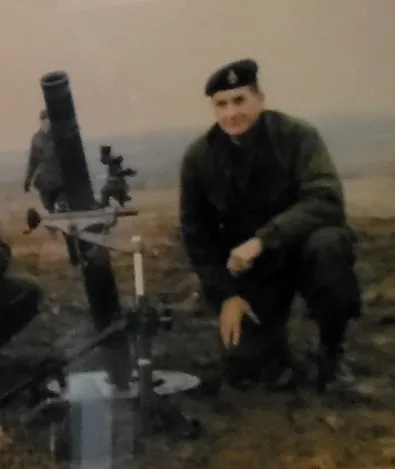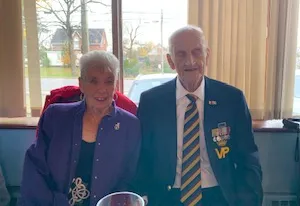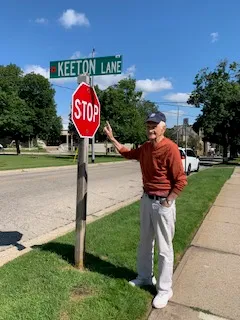6 Keeton Ln
Sergeant Douglas “Bud” Keeton
Bud Keeton was born in August 1930 in Paris, the son of Percy Keeton and Maggie Wain. He lived in the same house he lives in now, what was then 6 Broadway Lane, with brothers Jack and Bill and his sister May. He had been selling bread as a teenager, but jobs were difficult to find in 1949, so he decided to enlist the Princess Patricia Canadian Light Infantry. He was 18 years of age.

He was first sent to Wainwright, Alberta for training and then to Calgary. He was then sent for Airborne training in Brandon, Manitoba and Fort Lewis, in Washington State. He also trained as a medic at this time because, as he said, those classes were inside, and he did not like all the marching they had to do on parade. He was in the US for about six months and then he was shipped off to Korea.
Bud never got to use his medic training, and his parachute training was not needed in Korea either because the countryside was too hilly. Bud said his only job was to man the Bren gun each night. They only fought at night, he said, because that was when the Chinese forces attacked. He remembers them coming over the hill, all dressed in brown uniforms with white sneakers so they could advance quietly. The Canadians were given American rations, including canned soup. The soldiers put stones in the cans and then drew lots. The Canadians held the high ground, so the loser had to creep down the hillside and place the cans where the Chinese troops would knock them over. The noise would give the Canadians warning of an attack.
And he remembers the rain. They lived in pup tents and dug defensive trenches which they had to stand guard in, so they were always wet. Once when he got out of his tent to take his turn on guard, his friend Bruce Marshall, also from Paris, said to “go back to bed. I’m wet now.” The Canadian troops were sometimes lax about their uniforms. Bud said they did not often wear their helmets because they were uncomfortable.
From the summer of 1951 to the end of the war, most of the Canadian involvement centered on a small area north of Seoul “between the 38th parallel on the south and the town of Chorwon on the north. The Canadian war front was about 30 miles across and was a section of the United Nations front occupied by British Commonwealth forces. The Canadians’ two main adversaries during the war were the Korean People’s Army and the much larger Chinese People’s Volunteer Army. Canada’s military objective was to give military support that would lead to the resolution of the war.
Bud does not like to talk about encounters with the enemy, but the most serious battle for the Princess Pats was the Battle of Kapyong, which lasted from April 22, 1951 to April 25.
Under relentless Chinese pressure, 2PPCLI was surrounded and outnumbered by about 30 to 1. During the course of the fighting, 2PPCLI was completely exhausted of ammunition, medical supplies, and food, and forced to defend their positions with bayonets. By dawn the Chinese attack on the Canadian position had abated, and in the afternoon of 25 April the road through to the Canadians had been cleared of Chinese. Following a Canadian offensive to clear Hill 677 on 26 April, the 2nd Battalion was relieved. Canada lost 12 soldiers killed (out of allied losses of 59) and 35 wounded at this battle. Chinese casualties were estimated at about 1,000 killed and wounded. The Battle of Kapyong was a major setback for the Chinese Army.
Bud did not see the end of the Korean War in July 1953. He returned to Canada in 1952, but not before marching in the coronation of Queen Elizabeth in that year. He was one among 110 soldiers who were given that honour. Nevertheless, he had some difficulty readjusting to civilian life. He admits that many soldiers who came home from Korea were suffering from Post Traumatic Stress Disorder (PTSD) after what they witnessed in Korea.

At about that time he met Doreen Todd, who he would marry in 1959. He returned to the family home at 6 Broadway Lane. He worked first at McDonald-Oliver, a plumbing supply company, and then at Paris Poultry.

In June 2023, Broadway Lane was renamed Keeton Lane, in recognition of the three generations of Keetons who had lived there, but also to recognize and honour the courage and sacrifice shown by Bud through the time he spent in Korea. He was one of the Canadian soldiers, recognized for their military skill and courage, who contributed significantly to the preservation of South Korea as an independent nation, a role that remains an important, though once forgotten, chapter in Canada’s military history. And Canada’s participation in the Korean War paved the way for the development of Canada’s commitment to the United Nations and to the concept of peacekeeping.
